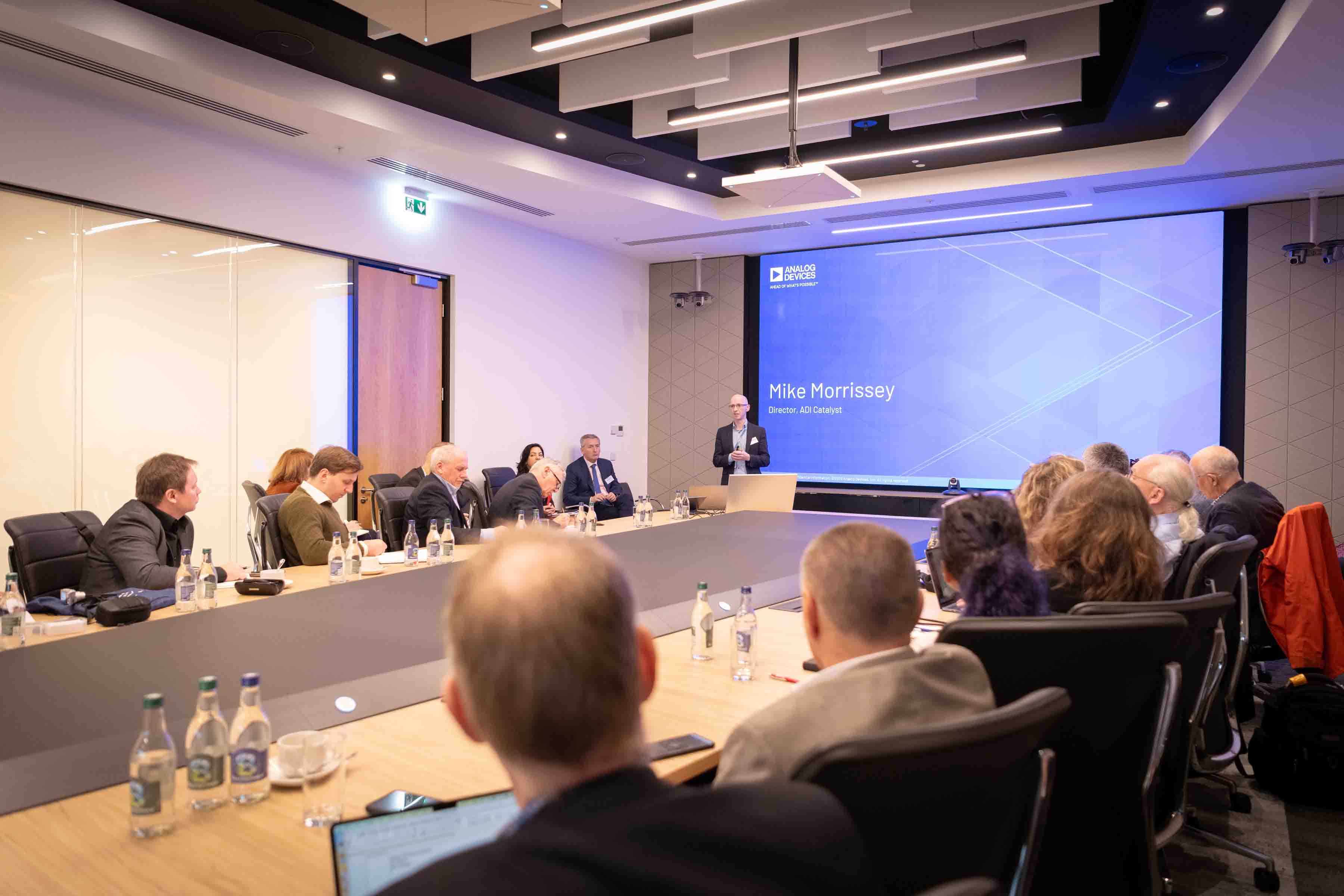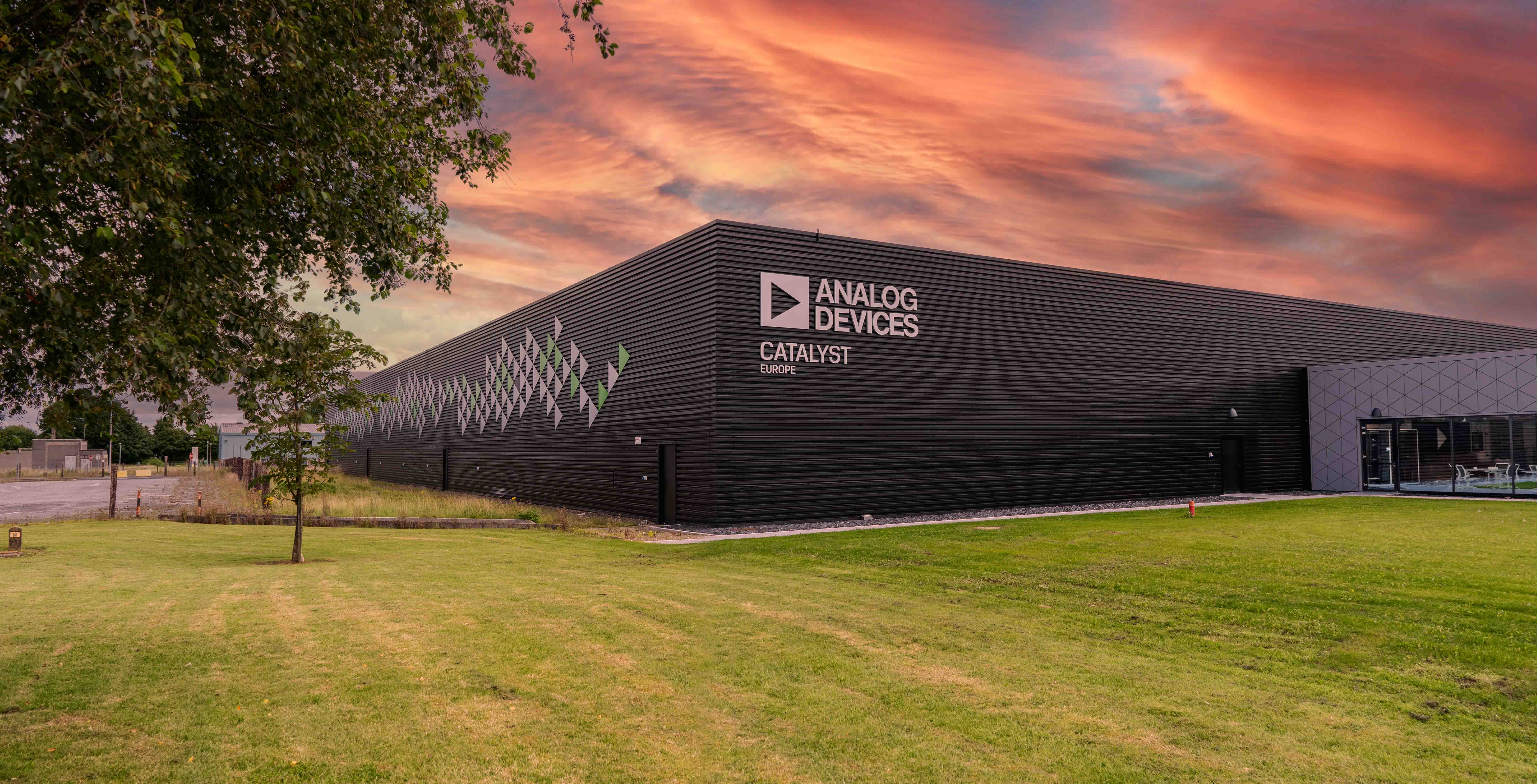How a small city in Ireland is accelerating the race to the industry of tomorrow
“A catalyst reaction creates an acceleration, and that’s why we called this facility Catalyst, as that’s what we aim to achieve here: acceleration,” Analog Devices Catalyst Director Mike Morrissey told a boardroom full of journalists.

Analog Devices Catalyst Director Mike Morrissey told a boardroom full of journalists.
Catalyst, the R&D development centre of Analog Devices Inc (ADI), opened its doors to members of the press on the 18th October 2023 for an intimate look at its current work, partnership and achievements, and ambitions for what the President of ADI’s EMEA region Martin Cotter believes is being made here: the industry of tomorrow.
Centred in Limerick, Ireland, the location might not strike the unassuming immediately as a ‘tech hub’, yet, ADI has had a hub there for over 50 years. Despite having a multinational footprint, with facilities from England to Australia, the American company has fabs in two of its locations, with Ireland being alongside the US as one of them. This decision to initially begin a facility in Ireland may have once yielded payoffs in the terms of tax incentives etc, yet the firm roots previously laid have weathered any changes in the economic circumstances of the country to keep the facility blossoming.
It’s this combination of factors that contributed to the decision to build Catalyst here, and in March 2022, the operation was opened. Costing €100 million, the 100,000 square foot centre is now one-third occupied with the remaining two thirds expected to fill over the next 12 months. Although the full expansion to bring in 250 new jobs will not be delivered until 2025, that has not held back any of the ‘acceleration’ that ADI has hoped to deliver.

ADI Catalyst facility in Limerick, Ireland
The prior facility traditionally acted as a component producer and supplier, what Catalyst adds to ADI’s offerings is a place where companies can come to innovate ideas, improve hardware, or find solutions to limitations or issues. For instance, a car entertainment company that is voice enabled might find that the cockpit of the vehicle suffers from outside noise interference, slightly distorting the input. Catalyst will work - very often with the hardware from the company in question – on the issue through a combination of hardware and software solutions to resolve the issue. Although companies coming to Catalyst are more looking for refinement than rectification, the appeal is the bespoke nature of the partnership ADI has with the companies that come to Catalyst. Being knowledgeable in hardware and solution creation, companies can get these quality solutions created by ADI specifically implemented into their products and for their direct circumstances, often utilising home-grown solutions like A2B Audio Bus for automotive environments.
What Catalyst builds on past the supplying of components and their implementation is the software support to integrate them into products. This is because, as an ADI staffer explained, “companies don’t just want the hardware anymore, they want the accompanying software so they can install as is.” Therefore, Catalyst is positioning ADI as a full solution provider.
This is all about bringing better products to market, whether it would be through innovation of the product or the process it comes about through. Yet, one would run the risk of being a jack of all trades would they focus on all areas. Therefore, Catalyst focuses on three key areas: Industry 4.0 and smart energy, automotive, and 5G and next-gen connectivity. These industries were represented on the day by clients ranging from telecoms giant Vodafone, VR company Varjo; chip manufacturer Intel, and pharmaceutical giant Johnson & Johnson. They are all part of this Catalyst academy.
Looking at the individual sectors of Catalyst, we can see the work they are currently engaged in.
Automotive
As previously mentioned, ADI specialises in innovation for the automotive sector, having one of the industry’s broadest portfolio. Its creation of A2B audio architectures addresses some of the trends of the industry, like the desire for low latency.
Speaking to Electronic Specifier, Yasmine King, Vice President, Automotive Cabin Experience at Analog Devices, said: “We created the A2B solution as there were a number of system-level issues present within digital audio bus interfaces available on the market that prevented us doing that.
“For the contemporary car-buyer, apps, user interface, and audio and video features are now just as important as driving dynamics, design, and comfort - the features that car makers have traditionally drawn on to sell their models.”
In addition to its A2B audio, ADI is currently working on a wireless battery management system to reduce cabling and the manufacturing time and complexities that come with it.
Connectivity
Catalyst is working with Intel and Vodafone to support their work on the RF part of OpenRAN with its OpenRAN5G Network Testbed. OpenRAN is an evolving telecommunications concept and technology that aims to disaggregate and standardise the various components of a wireless network's radio access infrastructure. Vodafone’s ambitions with ADI is to influence the design of silicon that will arrive in two or three years time.
Its efforts to address prevailing issues in the connectivity sphere, like global RAN energy consumption, has seen it build some of the lowest energy use SoCs for 5G radio units; its work reducing RU design hurdles seeks to alleviate the increasing radio resign complexity which is evolving due to the demands modern wireless communication has in multiple frequency bands and higher data rates.
Industry 4.0
‘Anchor’ partner Johnson & Johnson was at the site and works with ADI to address industrial 5G communications in factory and robotised facilities. Robots are one of the fastest growing trends within automation, with strong networks being key to their fluid operation. Johnson & Johnson spends $1 billion per year on factory automation so the success of the partnership opens up massive industrial markets.
With industry as a whole shifting to more eco innovations, and with buildings contributing to 35% of energy-related EU emissions in 2021, ADI has placed real importance on smart buildings. ADI Chronous, a scalable Ethernet solution created by the company, boast automation of a commercial building's HVAC system that can save up to 30% of energy costs.
Review
Catalyst is possible because of the increasing demand the automotive, communications, and industrial manufacturing sectors have to extend their involvement beyond their primary suppliers and reach further down the supply chain. This industry involvement with ADI at Catalyst will only serve to increase the innovations of the facility as more, and a broader range, of tinkering and testing is done and new things are learnt.
The fact that it has managed to woo big clients like Intel and Vodafone is testament to its value and opens the door for further ADI Catalyst centres to be open across its portfolio of global offices, with its regional headquarters in Japan being a potential candidate due to its strong position in the automotive, industrial, and communications sectors.


